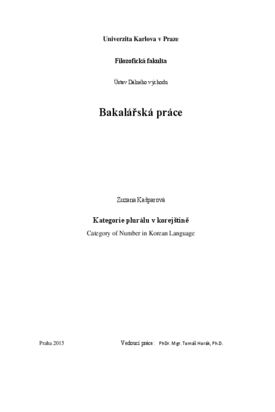Vyjádření kategorie plurálu v korejštině
Category of Number in Korean Language
bachelor thesis (DEFENDED)

View/
Permanent link
http://hdl.handle.net/20.500.11956/66573Identifiers
Study Information System: 124097
Collections
- Kvalifikační práce [23740]
Author
Advisor
Referee
Ferklová, Blanka
Faculty / Institute
Faculty of Arts
Discipline
Korean Studies
Department
Institute of East Asian Studies
Date of defense
6. 2. 2015
Publisher
Univerzita Karlova, Filozofická fakultaLanguage
Czech
Grade
Good
Keywords (Czech)
korejština, plurál, gramatická kategorie čísla, sufix -tŭl, typologieKeywords (English)
Korean, plural, grammatical category number, suffix-tŭl, typology(česky) Hlavním tématem předkládané bakalářské práce je problematika čísla s důrazem na korejštinu. Zabývá se jak konceptem jednosti a mnohosti, tak číslem jako mluvnickou kategorií. Důraz je kladen na specifický jev korejštiny, kde se morfém plurálu objevuje i na nenominálních větných členech a přináší tak nové sémantické a pragmatické funkce. V teoretické části je představena kategorie čísla obecně s ohledem na jazykovou typologii podle Skaličky. Hlavním tématem práce je kategorie čísla v korejštině - zaměřuje se na prostředky vyjádření čísla a dále se pak podrobněji věnuje plurálnímu sufixu -tŭl, který je nejběžnějším způsobem vyjádření plurálu v korejštině. Sufix -tŭl má dva základní typy. Práce se zabývá jak jeho "tradičnějším" výskytem s počitatelnými podstatnými jmény a zájmeny, tak komplikovanějšími výskyty s netradičními kategoriemi, jako jsou příslovce, slovesa atd. V závěru práce je rovněž stručně nastíněna (ne)produktivita zkoumaného jevu.
(in English): The submitted bachelor's thesis deals with the category of number with focus on Korean. The thesis deals both with the concept of singularity and plurality and with number as a grammatical category. The emphasis is placed on a specific phenomenon of Korean where the plural suffix appears even on non-nominal sentence elements and therefore it brings new semantic and pragmatic functions. A general presentation of the category of number with regard to Skalička's language typology is provided in the theoretical part. The main topic of the thesis is number in Korean - it studies on the means by which it can be expressed and it focuses specifically on the plural suffix -tŭl, which is the most common frequent way of expressing plural in Korean. The suffix -tŭl has two main types. The thesis deals both with the more "traditional" one that appears on countable nouns and pronouns and also with more complicated cases that appear with verbs and adverbs etc. The (un)productivity of the phenomenon is outlined in the end of the text.
